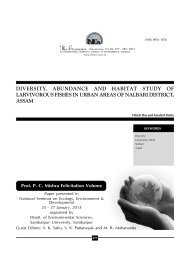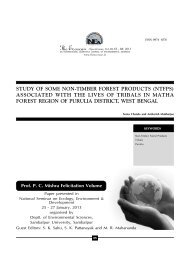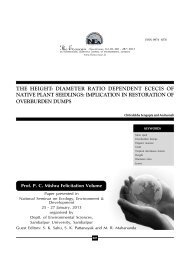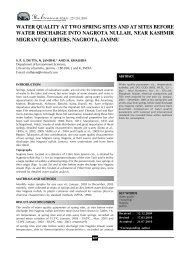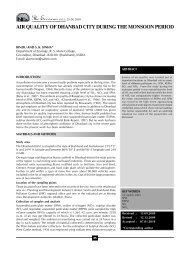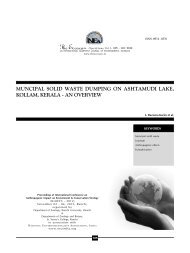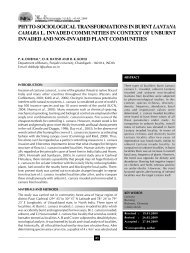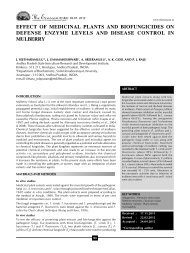Tripti Bouri.pmd - An International Quarterly Journal of ...
Tripti Bouri.pmd - An International Quarterly Journal of ...
Tripti Bouri.pmd - An International Quarterly Journal of ...
You also want an ePaper? Increase the reach of your titles
YUMPU automatically turns print PDFs into web optimized ePapers that Google loves.
ISSN: 0974 - 0376<br />
NSave Nature to Survive<br />
: Special issue, Vol. III: 69 - 74; 2013<br />
AN INTERNATIONAL QUARTERLY JOURNAL OF ENVIRONMENTAL SCIENCES<br />
www.theecoscan.in<br />
DOCUMENTATION OF TRADITIONAL KNOWLEDGE AND<br />
INDIGENOUS USE OF NON- TIMBER FOREST PRODUCTS IN<br />
DURGAPUR FOREST RANGE OF BURDWAN DISTRICT, WEST<br />
BENGAL<br />
<strong>Tripti</strong> <strong>Bouri</strong> and Ambarish Mukherjee<br />
KEYWORDS<br />
Non timber forest products<br />
Burdwan District<br />
Santhal communities<br />
Conservation<br />
Sustainable use<br />
Pr<strong>of</strong>. P. C. Mishra Felicitation Volume<br />
Paper presented in<br />
National Seminar on Ecology, Environment &<br />
Development<br />
25 - 27 January, 2013<br />
organised by<br />
Deptt. <strong>of</strong> Environmental Sciences,<br />
Sambalpur University, Sambalpur<br />
Guest Editors: S. K. Sahu, S. K. Pattanayak and M. R. Mahananda<br />
69
NSave Nature to Survive<br />
QUARTERLY<br />
TRIPTI BOURI* AND AMBARISH MUKHERJEE<br />
Centre for Advanced Study, Department <strong>of</strong> Botany,<br />
University <strong>of</strong> Burdwan, Burdwan - 713 104, West Bengal, INDIA<br />
E-mail: tbouribot@gmail.com<br />
ABSTRACT<br />
The present study documents the non timber<br />
forest products used by the tribal people <strong>of</strong><br />
Basudha beat <strong>of</strong> Durgapur Forest Range under<br />
Burdwan District, West Bengal. The local<br />
people mainly belong to Santhal communities.<br />
Their activities include collection <strong>of</strong> different<br />
non-timber items <strong>of</strong> forest resources and<br />
cultivation. This work records 131 plant species<br />
<strong>of</strong> angiosperms belonging to 60 family and<br />
118 genera. The taxonomic analysis shows<br />
that the dicot and monocot ratio is 114:17.<br />
Habit analysis shows that the herb: shrub:<br />
climber: tree composes the forest in the ratio<br />
<strong>of</strong> 29: 27: 16: 59 respectively. A precise account<br />
<strong>of</strong> their habit, common name and use category<br />
has been prepared which as a document might<br />
prove useful in stock-taking <strong>of</strong> biodiversity and<br />
their conservation through sustainable use.<br />
INTRODUCTION<br />
Forests around the world provide a massive variety <strong>of</strong> valuable products aside<br />
from the timber we use. Non-Timber Forest Products (NTFP) are defined as anything<br />
that is harvested or collected from forests that are not trees to be cut into timber.<br />
This includes a large variety <strong>of</strong> foods, medicines, fuel, forage, plants used for dye,<br />
and much more. The forest dwellers mainly belong to tribal communities and<br />
they mainly depend on forest flora for their livelihood. Some NTFPs are highly<br />
valuable in local and global markets. For exhaustible involvement <strong>of</strong> non timber<br />
forest products in commercial sphere directly from the forests as very valuable<br />
commodities, many species have been perceiving threat <strong>of</strong> extinction and<br />
necessitating immediate conservation and protection. In view <strong>of</strong> the importance<br />
<strong>of</strong> the non-timber forest products and their implications with forest conservation<br />
and livelihood <strong>of</strong> forest dwellers the present work was undertaken in the forested<br />
areas <strong>of</strong> Basudha Beat in Durgapur Forest Range <strong>of</strong> Burdwan district, West Bengal.<br />
MATERIALS AND METHODS<br />
Ethnobotanical surveys were carried out since 2009 in the forested areas <strong>of</strong><br />
Basudha beat under Durgapur Forest Range <strong>of</strong> Burdwan District to collect the<br />
primary data pertaining to phytoresources more or less following the standard<br />
methods (Rao, 1989). Pertinent plant specimens were collected which were<br />
processed for herbarium preservation as voucher specimens for future references<br />
as well as for identification using authentic literature (Prain, 1903; Guha-Bakshi,<br />
1984; Bennet, 1987). The voucher specimens have been preserved in the<br />
Herbarium <strong>of</strong> the Ecotaxonomy Laboratory <strong>of</strong> the Department <strong>of</strong> Botany, Burdwan<br />
University.<br />
Study site<br />
Basudha beat is located at 23º26’’N L and 87º27’’ E L under Kanksa Block <strong>of</strong><br />
Durgapur forest range <strong>of</strong> Burdwan District. This beat is located between the rivers<br />
Ajoy in the north and Kunur in the south. The local people are mainly Santhals<br />
and dependent on non-timber forest products for their livelihood (<strong>Bouri</strong> and<br />
Mukherjee, 2011; Mukherjee and <strong>Bouri</strong>, 2011). Their dependence on NTFPs is<br />
very high especially during subdued agricultural production. The soil is lateritic<br />
in nature. <strong>An</strong>nual rainfall is 1500 mm.<br />
RESULTS<br />
This work records 131 plant species <strong>of</strong> angiosperms (Table 1) belonging to 60<br />
families and 118 genera. The taxonomic analysis shows that the dicot and monocot<br />
ratio is 114:17 (Fig. 1). Habit analysis shows that the herb: shrub: climber: tree<br />
composes the forest in the ratio <strong>of</strong> 29: 27: 16: 59 respectively (Fig. 2).<br />
*Corresponding author<br />
DISCUSSION<br />
During an ethnobotanical study in Basudha beat <strong>of</strong> Durgapur Forest Range<br />
70
NON- TIMBER FOREST PRODUCTS IN BURDWAN, W. B.<br />
Table 1: <strong>An</strong> enumeration <strong>of</strong> Phytoresources and their uses as revealed from indigenous knowledge<br />
S. No. Name <strong>of</strong> the Plant Family Common name Habit Use category<br />
1. Abrus precatorius L. Fabaceae Kunch Shrub M, O<br />
2. Acacia auriculiformis A. Cunn Mimosaceae Akashmoni Tree Fue, Sy, HI<br />
3. Acacia catechu Willd. Mimosaceae Khoyer Small tree G<br />
4. Acacia holoserica A. Cunn Mimosaceae - Shrub Pp, Fue<br />
5. Acacia nilotica (L.) Del. Mimosaceae Babla Tree G, Fue, Fod, Ts,HI<br />
6. Acacia sinuate (Lour.) Nerrilla Mimosaceae Saptala Shrub Sy, M<br />
7. Achyranthes aspera L. Amaranthaceae Apang Herb E, M<br />
8. Aegle marmelos (L.) Corr. Rutaceae Bilva Tree C, E, BP<br />
9. Ailanthus excelsa Roxb Simarubaceae Mahanimbi Tree M<br />
10. Alangium salvifolium (L.f.) Wangerin Alangiaceae <strong>An</strong>kura Tree M, Fue, E, Ms<br />
11. Albizia lebbeck (L.) Benth Mimosaceae Sirisha Tree Fod, HI<br />
12. Alstonia scholaris (L.) R. Br. Apocynaceae Chhatim Tree M, O<br />
13. <strong>An</strong>drographis paniculata (Burm.f.) Wallich Acanthaceae Kalmegh Herb M<br />
14. <strong>An</strong>isomeles indica (L.) O. Kuntze Lamiaceae Gopali Herb M, Fue<br />
15. <strong>An</strong>nona squamosa L. <strong>An</strong>nonaceae Ata Tree E, Pes, M<br />
16. <strong>An</strong>thocephalus chinensis (Lamk.) Rich. Rubiaceae Kadamba Tree M, O, E<br />
17. Argyreia nervosa (Burm.f.) Bojer Convolvulaceae Guguli Climber M, O, E<br />
18. Aristida adscensionis L. Poaceae Shipri mullo Herb Sb, Brm, Th<br />
19. Aristolochia indica L. Aristolochiaceae Iswarmul Climber M<br />
20. Artocarpus heterophyllus Lamk. Moraceae Kanthal Tree Fod, E, Fue, Lp<br />
21. Asparagus racemosus Willd. Liliaceae Satmul Shrub M, E<br />
22. Azadirachta indica L. Meliaceae Nim Tree E, Ts, Pes, M<br />
23. Bambusa arundinacea Willd. Poaceae Vansh Tree M, Ms, E, Pp, HI, Bskt<br />
24. Bauhinia purpurea L. Caesalpiniaceae Vanraja Tree Dy, Fod, E<br />
25. Bauhinia vahlii Wight and Arn. Caesalpiniaceae Chehur Climber Fib, Lp, E<br />
26. Bixa orellana L. Bixaceae Sinduri Shrub Dy<br />
27. Bombax ceiba L. Bombacaceae Simul Tree M, Fue, C, HI<br />
28. Borassus flabellifer L. Arecaceae Tal Tree E, M, Th, Fue, Fib,<br />
BP,Mt,HF, Brm<br />
29. Bridelia retusa Spreng Euphorbiaceae Mahavira Tree E, Fod<br />
30. Buchanania lanzan Spreng <strong>An</strong>acardiaceae Piyal Tree M, E, Fod<br />
31. Butea monosperma (Lamk.) Taub Fabaceae Palas Tree M, Dy, Lp, Fod<br />
32. Butea superba Roxb. Fabaceae Latapalas Climber C, Dy, M, Fod,<br />
33. Canscora decussate (Roxb) Roem and Schult Gentianaceae Dankuni Herb M<br />
34. Capparis sepiaria L. Capparaceae Kaliakara Shrub M<br />
35. Careya arborea Roxb. Lecythidaceae Kumba Tree E, Fib, Bidi<br />
36. Carissa carandas L. Apocynaceae Karamcha Shrub E<br />
37. Cassia fistula L. Fabaceae Banarlathi Tree M, Cos<br />
38. Cassia sophera L. Caesalpiniaceae Kasamarda Shrub M,<br />
39. Centella asiatica (L.) Urb. Apiaceae Thankuni Herb M, E<br />
40. Cinnamomum tamala Nees Lauraceae Tejpata Tree Spice<br />
41. Clerodendrum viscosum Vent. Verbenaceae Ghetu Shrub M, BP<br />
42. Cocculus hirsutus (L.) Diels Menispermaceae Jol jamani Shrub E, M<br />
43. Combretum roxburghii Spreng Combretaceae Burilathi Shrub Fue, Fib<br />
44. Costus speciosus (Koenig) Smith Zingiberaceae Kushtha Herb E, O<br />
45. Croton roxburghii Balak. Euphorbiaceae Bhutankusa Tree M<br />
46. Cryptolepis buchanani Roem and Schult Asclepiadaceae Karanta Shrub Fib, M, Fib<br />
47. Curculigo orchioides Gaertn Hypoxidaceae Kalimusli Herb M<br />
48. Cuscuta reflexa Roxb. Convolvulaceae Sarnalata Climber M<br />
49. Desmodium triflorum DC. Fabaceae Kodali Herb Sb, Fod<br />
50. Dillenia pentagyna Roxb. Dilleniaceae Chalta Tree E, Lp, Ts, Th<br />
51. Dioscorea pentaphylla L. Dioscoreaceae Kanta alu Climber M, E<br />
52. Diospyros melanoxylon Willd. Ebenaceae Kendu Tree E, M, Bidi, HI<br />
53. Macrotyloma uniflorum (Lam.) Verdc Fabaceae Kurti kalai Climber E<br />
54. Drosera burmanii Vahl. Droseraceae Pan-peak Herb M<br />
55. Ehretia laeyis Roxb. Boraginaceae Papri Tree Fod<br />
56. Elephantopus scaber L. Asteraceae Gojialata Herb M, BP<br />
57. Emblica <strong>of</strong>ficinalis Gaertn Euphorbiaceae Amlaki Tree M, E<br />
58. Eragrostis tenella L. Poaceae - Herb Sb, Fod<br />
59. Eulophia nuda Lindle Orchidaceae - Herb M<br />
60. Evolvulus nummularius L. Convolvulaceae Sankhapuspi Herb M<br />
61. Ficus hispida L.f. Moraceae Kak dumur Tree M, E<br />
62. Flacourtia indica (Burm.f.) Merr. Flacourtiaceae Bouchi Shrub M, E<br />
63. Gardenia gummifera L.f. Rubiaceae Dikamali Shrub M, G<br />
71
TRIPTI BOURI AND AMBARISH MUKHERJEE<br />
S. No. Name <strong>of</strong> the Plant Family Common name Habit Use category<br />
64 Garuga pinnata Roxb. Burseraceae Rohora Tree M<br />
65. Gelonium multiflorum Juss. Euphorbiaceae Ban naringa Tree Fue, M<br />
66. Gliricidia sepium (Jacq) Kunth ex Walp. Fabaceae Saranga Tree M, Sb, HI<br />
67. Gloriosa superba L. Liliaceae Bishalanguli Climber M<br />
68. Gmelina arborea Roxb. Verbenaceae Gambhar Tree E, Pp, HI<br />
69. Grevillea robusta A. Cunn Proteaceae - Tree HI, Fue, O<br />
70. Grewia asiatica L. Tiliaceae Phalsa Tree E<br />
71. Gymnema sylvestre R. Br. Asclepiadaceae Ajasringhi Climber M<br />
72. Haldina cordifolia (Roxb.) Ridsdale Rubiaceae Haldu Tree C, HI<br />
73. Helicteres isora L. Rubiaceae Mrigashinga Shrub M, Fue, Fib, Pp<br />
74. Hemidesmus indicus (L.) R. Brown Asclepiadaceae <strong>An</strong>tamul Climber M, E, BP<br />
75. Holarrhena pubescens (Buch-Ham) Wall. Apocynaceae Kurchi Tree M<br />
76. Holoptelea integrifolia Plunch Ulmaceae Chhalla Tree E<br />
77. Ichnocarpus frutescens (L.) R. Br. Apocynaceae Dudhilata Climber M, O, Fence<br />
78. Imperata cylindrical (L.) Roems Poaceae Ulu Herb Sb, Pp, M<br />
79. Indig<strong>of</strong>era tinctoria L. Fabaceae Bon nil Herb Dy<br />
80. Ipomoea aquatic Fors Convolvulaceae Kalmi sak Herb E<br />
81. Justicia adhathoda L. Acanthaceae Vashaka Shrub M<br />
82. Lannea coromandelica (Hutt) Merrill <strong>An</strong>acardiaceae Jiwal Tree E, G, Pp<br />
83. Lantana camara L. Verbenaceae Putus Shrub Fue, M<br />
84. Limonia acidissima L. Rutaceae Kathbel Tree E, M<br />
85. Lippia javanica (Burm.f.) Spreng Verbenaceae - Shrub M, Fue<br />
86. Ludwigia octovalvis (Jacq) Raven Onagraceae Bhulavanga Herb M<br />
87. Madhuca longifolia (Koenig) Macbride Sapotaceae Mahua Tree C, BP, E, M, Oy, HI<br />
88. Mallotus phillippinensis Muell. Euphorbiaceae Sinduri Tree Dy, Pp<br />
89. Meyna spinosa Roxb Rubiaceae Moyena Shrub E, Fue<br />
90. Mimosa pudica L. Mimosaceae Lajja Herb M, O<br />
91. Mimosa rubicaulis Lamk. Mimosaceae Shaik-kanta Herb M<br />
92. Mitragyna parvifolia (Roxb.) Korth Rubiaceae Chakalda Tree C, HI<br />
93. Mucuna pruriens (L.) DC. Fabaceae Alkusi Climber E, M<br />
94. Naringi crenulata Roxb. Rutaceae Beli Tree M<br />
95. Ochna obtusata DC. Ochnaceae Kanaka champa Shrub M<br />
96. Phoenix acualis Buch- Ham. Arecaceae Bhui khejur shrub E, Mt, Brme<br />
97. Phoenix sylvestris (L.) Roxb. Arecaceae Khejur Tree E, Fue, BP,Ts, Fens, Brm<br />
98. Physalis minima L. Solanaceae - Herb M<br />
99. Piper longum L. Piperaceae Pipul Herb M, E<br />
100. Plumbago zeylanica L. Plumbaginaceae Chitra Shrub M<br />
101. Pongamia pinnata (L.) Pierre Fabaceae Karanj Tree Sy, E<br />
102. Psidium guava L. Myrtaceae Mansala Tree E, M, Ts<br />
103. Pterocarpus marsupium Roxb. Fabaceae Bijiak Tree M, E, G, Pp, Ms<br />
104. Rauvolfia serpentine (L.) Benth ex Kurz Apocynaceae Sarpagandha Shrub M<br />
105. Saccharum munja Roxb Poaceae Shar Herb Th, Sb, Fib, Bskt, Brm,<br />
Arw, Mt, HF<br />
106. Saccharum spontaneum L. Poaceae Kush Herb Sb, Th, Brm,<br />
107. Semecarpus anacardium L.f. <strong>An</strong>acardiaceae Bhelataka Tree E<br />
108. Shorea robusta Gaertn. Dipterocarpaceae Sal Tree C, Lp, Ts,E,I, Lo, R/G,HI<br />
109. Sida cordata Burm.f. Malvaceae Junka Herb M, Fib<br />
110. Sida rhombifolia L. Malvaceae Atibala Shrub M, Fib<br />
111. Smilax zeylanica L. Smilacaceae Kumarika Climber E<br />
112. Spermacoce hispida L. Rubiaceae - Herb M<br />
113. Spilanthes acmella L. Asteraceae Akarkara Herb M<br />
114. Stephania japonica (Thumb) Miers Menispermaceae Aknadi Climber M<br />
115. Strychnos potatorum L. Loganiaceae Kuchila Tree M<br />
116. Symplocos racemosa Roxb. Symplocaceae Lodh Tree M, Dy<br />
117. Syzygium cumini (L.) Skeels Myrtaceae Jambu Tree E, Fod, Ts,<br />
118. Tamarindus indica L. Caesalpiniaceae Tetul Tree M, E<br />
119. Terminalia arjuna (Roxb ex DC) W. and A. Combretaceae Arjuna Tree M, HI, Ts<br />
120. Terminalia bellirica (Gaertn) Roxb. Combretaceae Bohera Tree M, E<br />
121. Terminalia tomentosa Bedd. Combretaceae Asan Tree HI<br />
72
NON- TIMBER FOREST PRODUCTS IN BURDWAN, W. B.<br />
S. No. Name <strong>of</strong> the Plant Family Common name Habit Use category<br />
122. Trema orientalis (L.) Blume Ulmaceae Jiwanti Tree E, Fib<br />
123. Trewia nudiflora L. Euphorbiaceae Pindare Tree E, M, Pp<br />
124. Triumfetta rhomboidea Jacq. Tiliaceae Jhinjhirita Herb Fib<br />
125. Tylophora indica (Burm.f.) Merrill Asclepiadaceae <strong>An</strong>antamul Climber M<br />
126. Ventilago denticulata Willd Rhamnaceae Raktapita Climber M<br />
127. Vetiveria zizanioides (L.) Nash Poaceae Bena Herb Oy, Sb<br />
128. Vitex negundo L. Verbenaceae Nishinda Shrub Pes, I<br />
129. Woodfordia fruticosa Kurz. Lythraceae Dhatki Shrub Dy, G/R<br />
130. Zizyphus mauritiana Lam. Rhamnaceae Bonkul Tree E, Fue<br />
131. Zizyphus oenoplia (L.) Mill. Rhamnaceae Siakul Shrub E, Fue<br />
M- medicinal; O- ornamental; E- edibles; Dy- dye yielding; Fue- fuel; Ms- musical stick; Pp- paper pulp; C- cultural; Fib- fibre; BP- beverage and its processing; Lo-lamp oil; Lp-Leaf plate;<br />
Sb- soil binder; Ts- tooth stick; Cos- cosmetics; ; Fod- fodder and forage; I- incense; Pes- pesticide; Sy- soap yielding; Oy- oil yielding; G/R- gum/resin; HI- house hold goods and implements;<br />
Spic- spice; Brm- broom; Th/Fence- thatching/fencing; Bidis- bidis leaf; Mt- mat, Arw- arrow, Bskt- basket; HF- hand fan.<br />
Table 2: <strong>An</strong>alysis <strong>of</strong> the use potential <strong>of</strong> the concerned plant species<br />
S. No. Use category Total no <strong>of</strong> Commercial<br />
species used prospect<br />
1 Medicinal 81 +<br />
2 Edible 53 +<br />
3 Ornamental 8 _<br />
4 Dye yielding 7 _<br />
5 Fuel 18 _<br />
6 Paper pulp 9 +<br />
7 Cultural 7 -<br />
8 Fibre 12 +<br />
9 Beverage and 7 +<br />
its processing<br />
10 Leaf plate 5 +<br />
11 Soil binder 8 _<br />
12 Tooth stick 8 +<br />
13 Cosmetics 1 _<br />
14 Soap yielding 3 _<br />
15 Pesticides 3 +<br />
16 Oil yielding 2 _<br />
17 Gum /Resin 7 +<br />
18 Fodder and forage 12 _<br />
19 House hold goods 15 +<br />
and implements<br />
20 Fencing/Thatching 7 _<br />
21 Spice yielding 1 +<br />
22 Bidis leaf 2 +<br />
23 Miscellaneous 20 +<br />
Table 3: Details <strong>of</strong> miscellaneous use potential<br />
S. No. Use category Total no <strong>of</strong> Commercial<br />
species used<br />
prospect<br />
1. Lamp oil 1 -<br />
2. Incense 2 +<br />
3. Broom 6 +<br />
4. Mat 3 +<br />
5. Arrow 1 _<br />
6. Basket 2 +<br />
7. Hand fan 2 +<br />
8. Musical stick 3 +<br />
Burdwan District, the authors recorded through an intimate<br />
contact with the tribal people that there are at least twenty<br />
three (23) types <strong>of</strong> use categories <strong>of</strong> the plant species (Table 2).<br />
The first four mostly used categories are medicinal, edible,<br />
miscellaneous and fuel with 81, 53, 20 and 18 species<br />
respectively.The commercial prospects <strong>of</strong> many <strong>of</strong> the<br />
Dicot<br />
Monocot<br />
Figure 1: Concern <strong>of</strong> eicot and monocot taxa in non-timber forest<br />
products <strong>of</strong> the study site<br />
60<br />
50<br />
40<br />
30<br />
20<br />
10<br />
0<br />
Herb Shrub Climber Tree<br />
Figure 2: Species distribution among different categories<br />
medicinal plants seem to be very bright. A scientific study <strong>of</strong><br />
wild edible plants is important for assessment proximate<br />
principles which could be utilized in addressing the<br />
contemporary issues <strong>of</strong> nutrition and future issues <strong>of</strong> food<br />
security especially in developing countries. Seven species were<br />
found to be linked with cultural activities and three species in<br />
making musical instruments for use in such programmes. A<br />
perpetuation <strong>of</strong> cultural activities is certain to ensure<br />
conservation <strong>of</strong> phytoresources in concern.<br />
73
TRIPTI BOURI AND AMBARISH MUKHERJEE<br />
ACKNOWLEDGEMENT<br />
The authors are thankful to the tribal people <strong>of</strong> Basudha<br />
Forested areas for giving us the opportunity to record their<br />
indigenous knowledge during field work.<br />
REFERENCES<br />
Bennet, S. S. R. 1987. Name changes in flowering plants <strong>of</strong> India and<br />
adjacent regions. Triseas Publishers, Dehradun.<br />
<strong>Bouri</strong>, T. and Mukherjee, A. 2011. Biological spectrum <strong>of</strong> Bankati<br />
forest areas in Burdwan District, West Bengal. Indian J. Scientific<br />
Research. 2(4): 57-60.<br />
Guha Bakshi, D. N. 1984. Flora <strong>of</strong> Murshidabad District West Bengal,<br />
India. Scientific Publishers, Jodhpur, India.<br />
Mukherjee, A. and <strong>Bouri</strong>, T. 2011. Indigenous knowledge about the use<br />
<strong>of</strong> non-timber phytoresources as documented from forest areas under<br />
Durgapur Forest Range, Burdwan District. The Ecoscan. 1: 59-62.<br />
Prain, D. 1903. Bengal Plants, Calcutta, West Bengal.<br />
Rao, R. R. 1989. Methods and techniques in ethnobotanical study and<br />
research: some basic consideration. In: Methods and Approaches in<br />
Ethnobotany (Ed. S. K. Jain) Society <strong>of</strong> Ethnobotany, Lucknow. pp. 13-23.<br />
74





